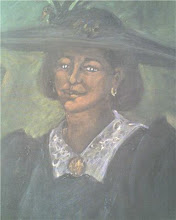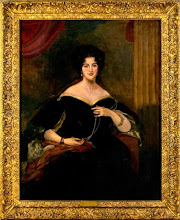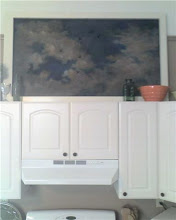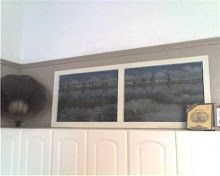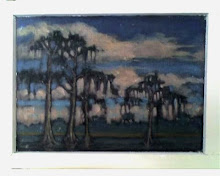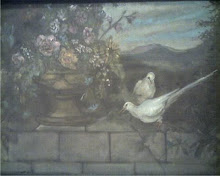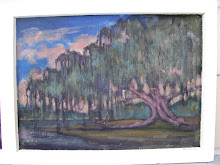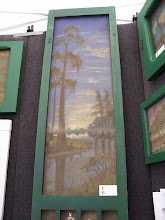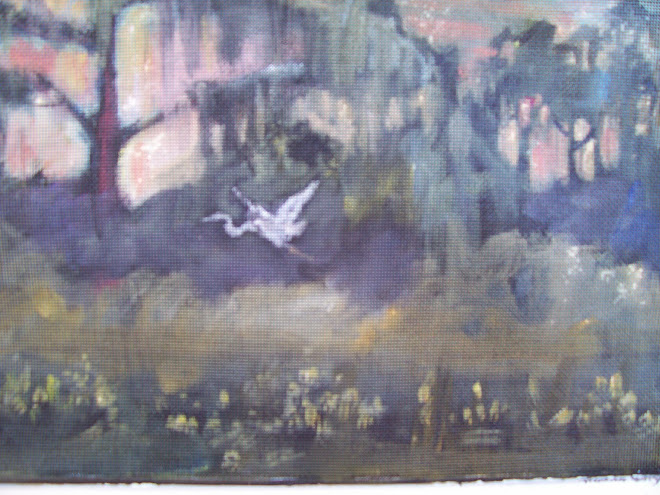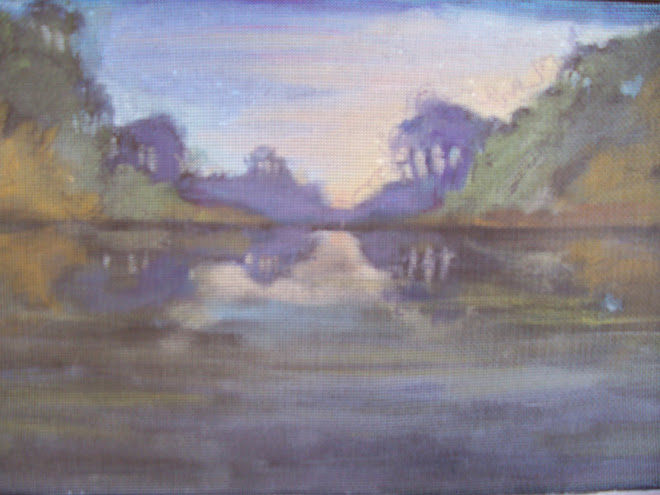Yesterday, I had a client drop off a painting to be surface cleaned. The client thought the painting was created by Rembrandt (1606-1669) 17th Century old master painter. The client acquired the painting from an estate auction at on of Louisiana's plantations. The painting is done well but, the painting is not by Rembrandt. There is a date on the front of the painting in roman numerals the letters appear as MDXVIII (1518). The artist painted the portrait on linen and used small L-shaped cut nails to nail the canvas to the stretcher bars. Nails during the 16th Century were hand forged one by one. The nails on my client's painting were created between 1790-1810 and were made from rods of steel cut to size.
I started to do more research and found out Raphael during the last years of his life did not have time to paint since he was commissioned to work on a huge marble sculpture project in Italy. Raphael lived to the age of 37 years old and many thought during his time period that the art world had lost their greatest artisian and thought his death was a tragedy. Raphael lived during the High Renaissance (the most productive and recognized period in art history). So, who is the young man in the portrait and who is the artist?
The painting was created in Europe and definately done by someone with academic training. During 1790 and 1830 wealthy American families traveled to Italy and marveled at old master paintings. Some families commissioned artists to paint copies of paintings or paintings in the style of old master painters. I have one example of Raphael's self portrait done when he was a young man next to our client's painting. I am thinking there was an artist that studied and admired Raphael's and Titian's portrait paintings and the early 19th Century artist created my client's portrait painting for an American family. Raphael and Titian did have students training in their studios and some students went on to become master portrait painters. http://www.tlbartrestoration.com/
Wednesday, September 30, 2009
Monday, September 28, 2009
Where to Display Screenscapes
Recently I had a question about where to display some of the larger screenscape paintings (besides over the headboard on the bedroom wall). In our own home in New Orleans we have screenscape paintings in the kitchen. We had space to fill over the cabinets and my collection of mixing bowls and bottles were not enough to fill the spaces (I am still looking for a huge copper stock pot to display and use to make Jerry's fantastic seafood gumbo).
I am still creating screenscapes to display on the ceiling. The screens are hung from the ceiling and show a New Orleans sky with chimney swifts birds flying in the cloudy sky. Chimney swift birds come out in the evenings in the French Quarter and still live in some of the old chimneys. The birds once lived in hollowed out cypress stumps and logs but, they were forced to live in chimneys after cypress swamps were harvested and destroyed the chimney swift birds' habitat.
Here are some display ideas for the screenscapes. Let me know your thoughts. http://www.tlbartrestoration.com/
I am still creating screenscapes to display on the ceiling. The screens are hung from the ceiling and show a New Orleans sky with chimney swifts birds flying in the cloudy sky. Chimney swift birds come out in the evenings in the French Quarter and still live in some of the old chimneys. The birds once lived in hollowed out cypress stumps and logs but, they were forced to live in chimneys after cypress swamps were harvested and destroyed the chimney swift birds' habitat.
Here are some display ideas for the screenscapes. Let me know your thoughts. http://www.tlbartrestoration.com/
Tuesday, September 22, 2009
Inspiration from Old Master Paintings
I just finished painting this image on copper screening. The original still life painting was painted by a 17th Century French old master painter. What I like most about the image is the landscape behind the still life (plus the white doves). I changed some of the coloring on the flowers and added a carved stone wall. I like to set the urn close to the edge of the wall to create some depth. Caravaggio used this composition in his still life paintings. Let me know your thoughts.
Visit: http:/www.tlbartrestoration.com/
Visit: http:/www.tlbartrestoration.com/
Sunday, September 20, 2009
Creating Screenscapes
The long process of prep work to paint on screens is never ending. My contractor is able to find old screens for me on his demolition and renovation jobs. The first step is to sort out which screens to clean and rescreen (with copper screening). I sometimes get screens that are crumbling away (oxidation and time have change the screen's strength). The older screens are woven tighter together and the tiny squares are closer together. Once oxidation starts on the screens they start acquiring a patina like a bronze displayed outdoors. Examples of oxidation on bronze is Rodin's 'The Thinker' and the Lion sculptures outside of The Art Institute of Chicago.
Once screens are cleaned I start painting the frames French Quarter green (a very dark green), off white, or black. I keep the backside of the screen window or transom the original color (to show original color).
Selecting what landscape is easy. Whatever, landscape and sunset inspires me I paint. I am not able to paint a sunset in fifteen minutes so, I take pictures since a sunset changes constantly within a fifteen minute period. I sometimes add native birds and maybe a flat boat. I do not like to paint people into the landscape since, some patrons ask who the person is and if the person is no one they know they tend to not want the screenscape painting.
My favorite screenscape paintings are the ones with the huge live oaks with spanish moss hanging from the braches of the trees. I sometimes see children making spanish moss wigs to where on their heads or huge spanish moss resting beds.
I sometimes get commissions to paint Jackson Square or Pirate's Alley on the screens but, landscapes seem to be my most desired images. The waters in Louisiana tend to be a dark brown or green which creates the perfect reflecting pools. Seeing a Louisiana sunset in calm waters is very relaxing and water tends to be a symbol of rebirth for me. Every sunset is different and the colors change from one season to the next. I notice in the fall the colors are more vibrant golds and pinks and peaches. I often wonder if some of the colors in old plantation homes were inspired by a Louisiana sunset.
Creating a screenscape averages about ten hours unless I get a huge window screen that becomes a panoramic landscape view. Visit: http:/www.tlbartrestoration.com/
Once screens are cleaned I start painting the frames French Quarter green (a very dark green), off white, or black. I keep the backside of the screen window or transom the original color (to show original color).
Selecting what landscape is easy. Whatever, landscape and sunset inspires me I paint. I am not able to paint a sunset in fifteen minutes so, I take pictures since a sunset changes constantly within a fifteen minute period. I sometimes add native birds and maybe a flat boat. I do not like to paint people into the landscape since, some patrons ask who the person is and if the person is no one they know they tend to not want the screenscape painting.
My favorite screenscape paintings are the ones with the huge live oaks with spanish moss hanging from the braches of the trees. I sometimes see children making spanish moss wigs to where on their heads or huge spanish moss resting beds.
I sometimes get commissions to paint Jackson Square or Pirate's Alley on the screens but, landscapes seem to be my most desired images. The waters in Louisiana tend to be a dark brown or green which creates the perfect reflecting pools. Seeing a Louisiana sunset in calm waters is very relaxing and water tends to be a symbol of rebirth for me. Every sunset is different and the colors change from one season to the next. I notice in the fall the colors are more vibrant golds and pinks and peaches. I often wonder if some of the colors in old plantation homes were inspired by a Louisiana sunset.
Creating a screenscape averages about ten hours unless I get a huge window screen that becomes a panoramic landscape view. Visit: http:/www.tlbartrestoration.com/
Saturday, September 19, 2009
Thoughts on Paul and Julia Child's Cambridge Home
I recently read about the new owners of Paul and Julia Child's home have the Cambridge home up for sale again. Julia's kitchen was lovingly donated to the Smithsonian and was shown in the movie, 'Julie & Julia'. The victorian Cambridge home was gutted to the studs and the interior was changed to modern. The once charming, inviting, spirited home is now cold and sterile (note the current owners are "veggie people" and anti-beef ). The home was featured once in Architecture Digest and I think online one can see the before and after photos. I am sure Julia would have a good laugh about her old kitchen becoming a "no beef" kitchen.
In my own home I try to keep things simple, classic, and welcoming. I incorporate new with old and rooms are furnished so, that a guest can sit in comfort and not feel like they are visiting a museum. Collecting art and antiques with stories and family history is my most interesting challenge. It's in my blood to recapture the nostalgia of the past.
I once talked on public radio about the "front porch generation" and how Americans have changed the tradition of entertaining and visiting people on huge front porches. Most families nowadays gather on decks or backyard outdoor kitchens (with fireplaces). I have fond memories of visiting my grandparents during the hot Indiana summers. My family would visit with neighbors on front porches or screen houses. The summer party at my grandparents' home was a huge social gathering for people wanting mounds of food (displayed on dining room table and various side tables). Family and guests would gather, eat, rest, and talk on the front porch. The front porch aluminum glider with its matching rocker was the seating of choice (otherwise one was forced to sit on lawn chairs).
I visited my grandparents home years after their deaths and the new owners built a huge deck and stone patio off of the old family room ( located to the back of the house). My grandmother's rose gardens were gone and only the hardiest roses survived the changed landscape. The new owner's gave me a tour of the home and everything was modern and new. The once tan walls with blonde wood trim was changed to gray walls with white painted trim. The floors stained dark and furniture purchased from a wholesale furniture outlet in Chicago. The wall where my grandmother had her stereo and record player (Zenith) had a huge flat screen television mounted to the wall ( I remember the huge waterfall oil painting that used to be on the same wall). I start thinking I should leave but, the curious cat in me went on to take the rest of the home tour. The kitchen that used to have the smells of fresh dill, garlic, and soup cooking (all year round) were gone. The smell of moth balls was gone and I felt sick to my stomach. I told the owner they had done a nice job but, I was being polite and holding back the tears and true comments. I know everything changes and one can never go "back home". I just find people's decorating ideas on what makes a house a home very interesting. Let me know your thoughts. Thomas
In my own home I try to keep things simple, classic, and welcoming. I incorporate new with old and rooms are furnished so, that a guest can sit in comfort and not feel like they are visiting a museum. Collecting art and antiques with stories and family history is my most interesting challenge. It's in my blood to recapture the nostalgia of the past.
I once talked on public radio about the "front porch generation" and how Americans have changed the tradition of entertaining and visiting people on huge front porches. Most families nowadays gather on decks or backyard outdoor kitchens (with fireplaces). I have fond memories of visiting my grandparents during the hot Indiana summers. My family would visit with neighbors on front porches or screen houses. The summer party at my grandparents' home was a huge social gathering for people wanting mounds of food (displayed on dining room table and various side tables). Family and guests would gather, eat, rest, and talk on the front porch. The front porch aluminum glider with its matching rocker was the seating of choice (otherwise one was forced to sit on lawn chairs).
I visited my grandparents home years after their deaths and the new owners built a huge deck and stone patio off of the old family room ( located to the back of the house). My grandmother's rose gardens were gone and only the hardiest roses survived the changed landscape. The new owner's gave me a tour of the home and everything was modern and new. The once tan walls with blonde wood trim was changed to gray walls with white painted trim. The floors stained dark and furniture purchased from a wholesale furniture outlet in Chicago. The wall where my grandmother had her stereo and record player (Zenith) had a huge flat screen television mounted to the wall ( I remember the huge waterfall oil painting that used to be on the same wall). I start thinking I should leave but, the curious cat in me went on to take the rest of the home tour. The kitchen that used to have the smells of fresh dill, garlic, and soup cooking (all year round) were gone. The smell of moth balls was gone and I felt sick to my stomach. I told the owner they had done a nice job but, I was being polite and holding back the tears and true comments. I know everything changes and one can never go "back home". I just find people's decorating ideas on what makes a house a home very interesting. Let me know your thoughts. Thomas
Friday, September 18, 2009
Art Sales and Discounts
The patron that wants the great art discount. I think people would be surprized how much a gallery takes after an artist's art sale. The usual percent is 60% unless you get a gallery owner that is willing to go 50%. I try to price my work to be affordable (between $125-$1200). I still get patrons wanting 10% off and I honor that discount. I do have an art director and she gets her percentage from the art sale. She is there at the gallery to talk and promote my art and to give a short biography about my art training and experiences. Some art directors go on to make very huge incomes and sometimes make more than the artist (if representing more than one artist). I was once told the waiter at a restaurant makes more than the chef. I think the waiter and chef would be upset if the customer asked for a special discount on the meal and tip. Some patrons think shopping for art is like shopping for shoes on sale or the special of the day at your local grocery store. Lets take for example when I price a painting for $500 and a patron gets the $50 discount which brings the final sale to $450 (not including sales tax). The gallery takes their cut from the final sale and I am left with $225. I spent 10 hours to prep and paint the image on the screen which means I am making $11.50 an hour (plus the expense for paints and brushes). I am not complaining but, I do find patrons requests to get more than 10% off insulting when my work is priced to sell. Clearly you can see I am not doing this to get rich but, to give art partons something that hopefully will be hung in their homes and passed on to other family members. Trust me the screenscape painting will go up in value once I am dead and gone. Unless I become a living master painter like Odd Nerdrum (his paintings sell for over $40,000). Think of the gallery's percentage on that art sale. Let me know your thoughts. Thomas
Thursday, September 17, 2009
Working Studio
Working today on restretching equestrian painting onto stretcher bars and start inpainting areas of fills and paint loss. This is where the magic begins and my favorite part of the painting conservation process. Inpainting involves only painting within the areas of paint loss. I was lucky to have a grandfather that taught me how to mix colors. The paint colors of yellow, red, blue, black, and white can be mixed to create any color (except neon colors that glow in the dark).
I had a call this morning to present a bid on restoring a huge WPA mural. I wish our government would start another WPA program for artists. Creating art for public areas and buildings would give unknown artists an opportunity to build their portfolio and get recognition. Thomas Hart Benton is probably my favorite artist during the movement for "Public Art". Once old master artists told stories from the bible with huge paintings and frescos. The WPA artists told stories about the working class and the machine age. The strentgh of both being used to build our cities and farm our lands. Once World War II was over and service men came back to the states to start families and our government switched gears and started giving war veterans the chance to buy a home or get a college education. The working factory man was replaced by machines that could work around the clock. Next came the computer age and another push for higher education. I wonder what artists would paint or sculpt now for "Public Art". Odd Nerdrum paints the future of mankind as grim and survival of the strongest. At the New Orleans Museum of Art ,artist, Odd Nerdrum's painting "The Water Hole" depicts five figures around a small waterhole. The persons carry weapons and are clothed with whatever they can find. No Channel or Ralph Lauren labels to be found on these characters. Let me know your thoughts on "Public Art".
I had a call this morning to present a bid on restoring a huge WPA mural. I wish our government would start another WPA program for artists. Creating art for public areas and buildings would give unknown artists an opportunity to build their portfolio and get recognition. Thomas Hart Benton is probably my favorite artist during the movement for "Public Art". Once old master artists told stories from the bible with huge paintings and frescos. The WPA artists told stories about the working class and the machine age. The strentgh of both being used to build our cities and farm our lands. Once World War II was over and service men came back to the states to start families and our government switched gears and started giving war veterans the chance to buy a home or get a college education. The working factory man was replaced by machines that could work around the clock. Next came the computer age and another push for higher education. I wonder what artists would paint or sculpt now for "Public Art". Odd Nerdrum paints the future of mankind as grim and survival of the strongest. At the New Orleans Museum of Art ,artist, Odd Nerdrum's painting "The Water Hole" depicts five figures around a small waterhole. The persons carry weapons and are clothed with whatever they can find. No Channel or Ralph Lauren labels to be found on these characters. Let me know your thoughts on "Public Art".
Wednesday, September 16, 2009
Studio Work
Today I started relining a period equestrian painting. The painting had major overpainting in the sky (past restoration done badly). I removed all of the overpainting and cleaned the back of the canvas to prep for relining. Relining helps to stablize old canvas and the painted image. Some artists used thin linen canvas and over the decades the canvas is exposed to different temperatures and environments. A good linen canvas will last over a hundred years but, when the painting is not taken care of properly the linen canvas begins to rot. I have worked on some paintings where the canvas is powder and the gesso and oil paint are the only materials left on the stretcher bars.
At noon I took a break and started working on the screens for the fall Poydras Home Art Show. The exhibit and juried show is attended by a lot of local collectors and last year's show was a hit. The screenscape paintings were the talk of the show and I sold screenscapes months after the show. Painting on old windows, screen doors and transom screens is quit the challenge. Some screening is copper or brass. The aluminum screens tend to fall apart and crumble just touching them with a brush. The right material does matter just like with using the right linen canvas for a painting. I have painted on linen canvas and sold paintings on canvas but, for some reason I am drawn to the challenge of painting on old screens. People tell me they feel like they are looking through a screen at a Louisiana landscape. I tend to paint marshes, ponds, bayous, and swamps at sunset. The painted images on screen change with the light in one's setting. Cloudy days the images look dark and sunny days the images look light and airy. I love to paint trees (willows and live oaks) and the reflection of a tree in water is very peaceful to me. People tend to feel at peace with my paintings and that is my whole goal recently. I want to paint images that are meaningful to people. The money is good but, seeing the happiness in other people's faces is more rewarding. Let me know your thoughts. Thomas
At noon I took a break and started working on the screens for the fall Poydras Home Art Show. The exhibit and juried show is attended by a lot of local collectors and last year's show was a hit. The screenscape paintings were the talk of the show and I sold screenscapes months after the show. Painting on old windows, screen doors and transom screens is quit the challenge. Some screening is copper or brass. The aluminum screens tend to fall apart and crumble just touching them with a brush. The right material does matter just like with using the right linen canvas for a painting. I have painted on linen canvas and sold paintings on canvas but, for some reason I am drawn to the challenge of painting on old screens. People tell me they feel like they are looking through a screen at a Louisiana landscape. I tend to paint marshes, ponds, bayous, and swamps at sunset. The painted images on screen change with the light in one's setting. Cloudy days the images look dark and sunny days the images look light and airy. I love to paint trees (willows and live oaks) and the reflection of a tree in water is very peaceful to me. People tend to feel at peace with my paintings and that is my whole goal recently. I want to paint images that are meaningful to people. The money is good but, seeing the happiness in other people's faces is more rewarding. Let me know your thoughts. Thomas
Burgher Art Conservation Studio and Fine Art
I live in New Orleans, Louisiana and work as an art conservator for paintings and frames. I spend my free time painting Louisiana landscapes on old copper screening salvaged from homes being demolished or renovated in historic neighborhoods in New Orleans. My academic training at Indiana University has helped me to accompish many of my artistic goals. The response to my screenscape paintings has been amazing and I am keeping a diary about me creating a series of New Orleans' parks for the Poydras Home Art Show. Visit: http://www.tlbartrestoration.com/ and read about my business.
Subscribe to:
Posts (Atom)

